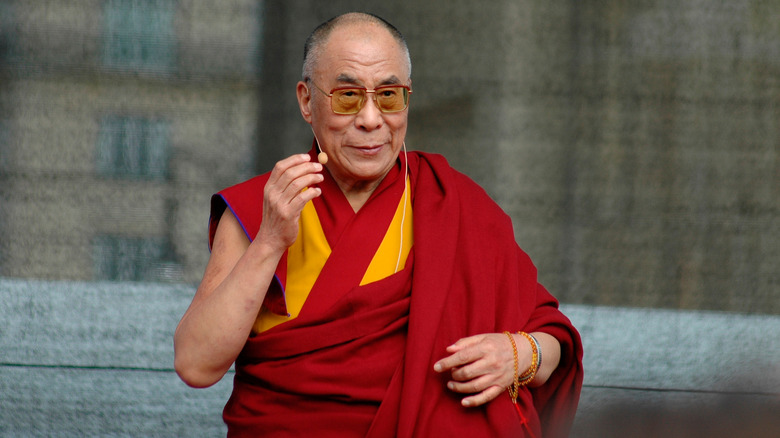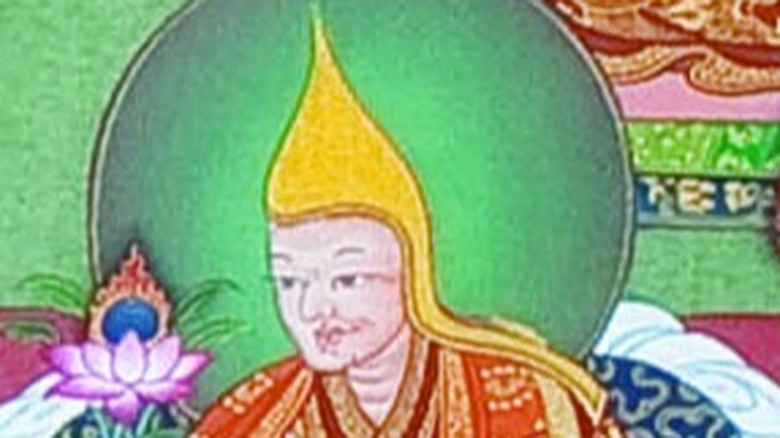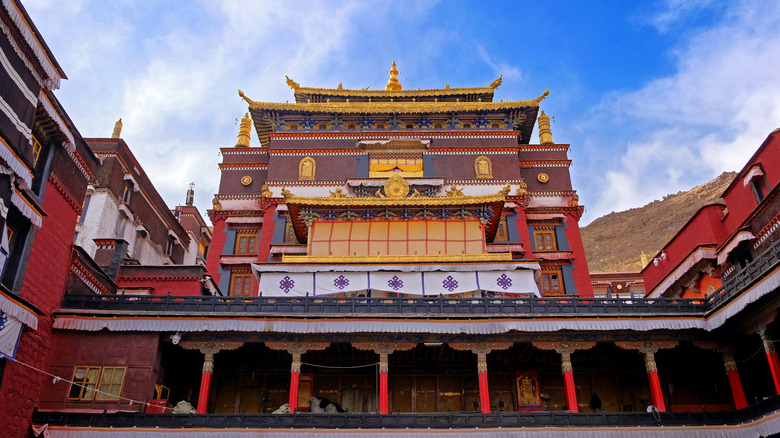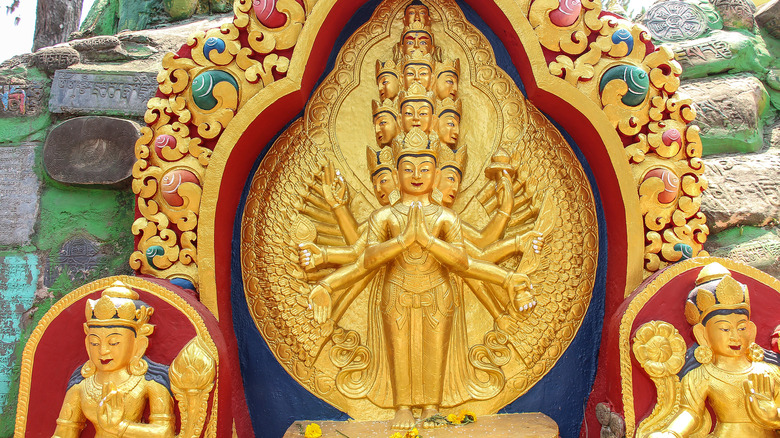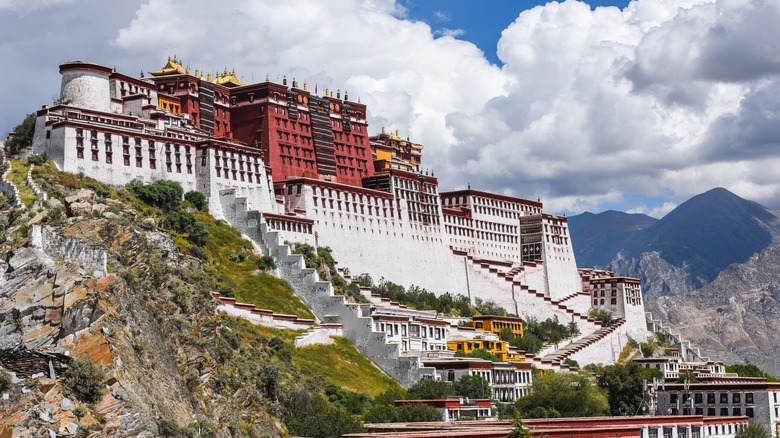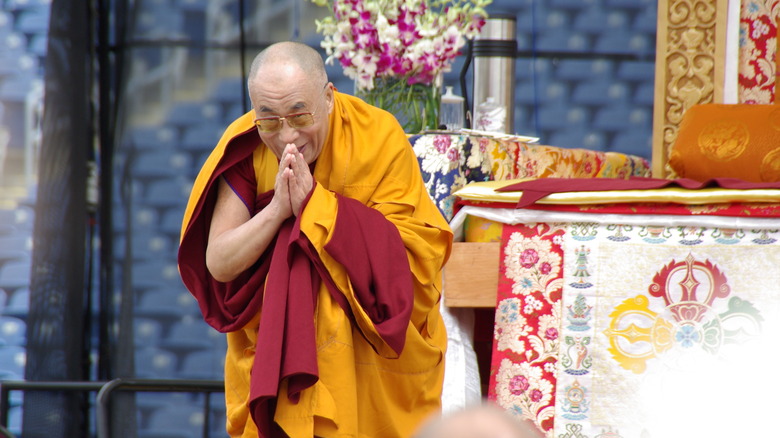Who Was The First Dalai Lama?
Finding the Dalai Lama is a little bit like a spiritual scavenger hunt. The current, and 14th Tibetan spiritual leader, started life with humble roots in the tiny village of Taktser, according to the Noble Peace Prize website. Discovering him began with the death of the 13th Dalai Lama, with monastery disciples relying on signs to locate the next one. These appeared with the body position of the past Holiness, which indicated that the new leader lived somewhere in northeast Tibet, reported The Conversation. The spiritual search team also consulted Lhamoi Latso, a lake that inspires visions of the leader's rebirth. Everything pointed to two-year-old Lhamo Thondup, who identified possessions of his predecessor, including rosary beads, a drum, and walking stick.
Before this, the new Dalai Lama showed few signs of future greatness. "I myself likewise had no particular intimation of what lay ahead. My earliest memories were very ordinary," he is quoted on the official Dalai Lama website. As farmers, his parents produced barley, buckwheat, and potatoes. His Holiness remembers visiting the chicken coop with his mother to collect eggs and making clucking sounds as he sat there.
When he became the newest Dalai Lama, Thondup, whose name changed to Tenzin Gyatso, embraced his identity as the re-incarnation of 13 previous Dalai Lamas, including the first one born in 1391 C.E. "I am often asked whether I truly believe this," he said. "The answer is not simple to give... I have no difficulty accepting that I am spiritually connected."
A Buddhist teacher is born
The first Dalai Lama never knew his role as part of a line of spiritual leaders as he gained the title posthumously. Born Pema Dorjee in Gyurmey Rupa in central Tibet to nomadic farmers, he found future satisfaction in spirituality and scholarship, states the official Dalai Lama website. Early on he showed his potential for greatness. Legend tells a story about how on the eve of his birth, bandits entered his family's camp. Before fleeing, his mother placed him amid the rocks, covered him in blankets, hoping to protect him from the thieves. When she returned in the morning, she found a raven deterring the crows and vultures circling about his helpless form. Folklore offered that the bird was actually Mahākāla, a deity later associated with the future leader.
Even as a child, the first Dalai Lama leaned toward religion and stories tell of his propensity to practice carving stones with sacred text. When his father, Gonpo Dorje, died, his mother, Jomo Namkyi, allowed him to enter the Nartang monastery to study at just seven years old. He received a new name, Gendun Drupa Pel, at 15, during his novice vows. By 20, the one-day Dalai Lama received his ordination as a monk and received a new title: thams cad mkhyen pa or "omniscient." The phrase recognized his scholastic ability, especially in Vinaya (essentially doctrine) and logic. By 25, the first Dalai Lama began finding other teachers that would transform his belief system and legacy (via Treasury of Lives).
The Dalai Lama legacy starts
Gedun Drupa (sometimes also called Gendun Drub/Drupa, or Gendun Drup) first studied under Tsongkhapa, founder of the well-known Gelugpa School, as reported by the official Dalai Lama website. He became so dedicated to the scholar that Tsongkhapa eventually treated Gedun Drupa as his main disciple and gave him robes to signify Gedun Drupa's importance in teaching the Tibetans about Buddhism. Tsongkhapa's branch of the religion became known as Gelug (or "Way of Virtue"), states World Atlas. The first Dalai Lama also experienced the benefit of studying with Sherab Sengge, who also embraced Tsongkhapa's philosophies, reports Treasury of Lives. For a dozen years, the two traveled to Tsang monasteries while passing along their teacher's perspectives.
By 1432, the first Dalai Lama presided as abbot over the Tanak Riku monastery and constructed another facility for learning at the Jangchen Monastery. He continued building religious spaces that featured Gelug teachings, including Tashilhunpo (also known as Tashi Lhunpo) in 1447. It was then that three colleges were also constructed specifically for religious studies. Tashihunpo in Shiagatse City still exists as one of the six most important Gelugpa monasteries for Tibetan Buddhists, per Tibet Travel.
The first Dalai Lama even created a prayer festival at Tashilhumpo based on one that his old mentor Tsongkhapa created in 1409. This new festival occurred in 1463 and again in 1474. The latter was attended by 1600 monks and around 10,000 individuals, and helped cement Gelug's importance in the Tsang area (via Treasury of Lives). Between all this, Gedun Drupa, also wrote eight books about Buddhism, according to the official Dalai Lama website.
The phrase Dalai Lama begins
The first Dalai Lama died in 1474 at the age of 84 during his meditation time at Tashihunpo, the monastery he founded, states the official Dalai Lama website. But his work was only beginning. The title of Dalai Lama came to him only after two others took over the role. Becoming the Dalai Lama only occurs if an individual is a tulku or a reincarnate vessel that holds past masters, according to Learn Religions. Every Dalai Lama also embodies Avalokiteśvara, also known as Chenrezig, the Bodhisattva or deity of compassion for Buddhists.
The term Dalai Lama officially started being used in 1578 when Altan Khan, the leader of the Mongols, bestowed the moniker on Sonam Gyatso, the third Dalai Lama in the Gelug sect. The phrase, which translates, into "oceans of wisdom," was also given to Gedun Drupa and Gendun Gyatso, Dalai Lama #2. The grandson of the ruler later became the fourth Dalai Lama, and benefitted from Mongol support to rid Tibet of another sect, Karma-pa, to become the country's ruler (via Britannica).
The second Dalai Lama, Gendun Gyatso, born Sangye Phel, was identified as the incarnation of Gedun Drupa at 11 years old, states Learn Religions. He spent his early years before his ordination at Tashilhunpo learning Buddhist philosophies. Later, he presided over Drepung and Sera monasteries as an abbot just as his successor, Sonam Gyatso — the first Dalai Lama to receive the title during his life — would. The third Dalai Lama also created the Namgyal and Kumbum monasteries.
14 Dalai Lamas and their history
The rebirth of the first Dalai Lama, Gedun Drupa, and the others after him continued for 13 more cycles. Some of them showed who they were as children. For instance, Gedun (aka Gendun) Gyatso allegedly told his parents his real name was Pema Dorjee, the same one that the first Dalai Lama was born with, according to the official Dalai Lama website. The third Dalai Lama, Sonam Gyatso, was recognized as his holiness at just 3 years old. The fourth, Yonten Gyatso, was identified as his predecessor's reincarnation as a child, but his parents kept him home until he turned 12, learning from the Tibetan Lamas in Mongolia. He also became an abbot at Drepung and Sera monasteries, and died at age 27.
Lobsang Gyatso, the fifth Dalai Lama, needed to keep secrets. Turbulent times delayed his religious education at Drepung monastery, but by 1642, the Dalai Lama's leadership position was recognized and he started building the Potala Palace — a feat that required almost 43 years to finish. His death in 1682 at 65 was not announced because of fears that the palace would not be completed. Instead, the public thought the Dalai Lama was on a retreat. The charade only was dismantled years after the new, and sixth Dalai Lama, was installed in 1697, some nine years after he was first discovered. Legend offers that Tsangyang Gyatso may have pinpointed the next, and seventh, Dalai Lama after writing a song that mentioned Lithang where, indeed, #7, Kelsang Gyatso was born (per the official Dalai Lama website).
The Dalai Lama moves into modern times
The eighth Dalai Lama, Jamphel Gyatso, provided auspicious signs from the moment of his conception when his birthplace Lhari Gang was blessed with a good harvest. Even as a baby he tried positioning himself into lotus form, and often looked at the heavens smiling. The ninth Dalai Lama, Lungtok Gyatso, was born in 1805, a year after his predecessor died. Although he took his novice vows, Lungtok Gyatso never reached his potential, dying at age nine. Tsultrim Gyatso, the 10th Dalai Lama, also died young in 1837, about 15 years after he was recognized. Khedrup Gyatso, #11, only guided the Tibetan people briefly before dying at 17 (via the official Dalai Lama website). The 12th Dalai Lama, Trinley Gyatso, also died early, becoming Tibet's leader at 18, but passing away before turning 20, reports Learn Religions.
Thubten Gyatso, dubbed the Great Thirteenth, had a longer reign. During his tenure, Tibet was invaded. First by Britain in 1903, who left after a short occupation, and then by China in 1910. The Great Thirteenth left for India but later returned in 1913 when Tibet regained its independence. Thubten Gyatso tried to modernize his country during his leadership. The current and 14th Dalai Lama, Tenzin Gyatso, also faced challenges from a Chinese invasion in 1950. Then the 1959 Tibetan Uprising forced Tenzin Gyatso to flee his country as an exile. Since then, he continues his work as a worldwide spiritual leader, even winning the Nobel Peace Prize in 1989.
